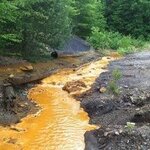Environment

New geochemical tracers can identify any hydraulic fracturing flowback fluids that could have spilled into the environment, according to field tests at a spill site in West Virginia and downstream from an oil and gas brine wastewater treatment plant in Pennsylvania.
Using boron and lithium tracers, scientists can determine if fracking fluid contamination has been released into the environment, which will help identify ways to improve disposal and treatment of shale gas wastewater.
Hydraulic fracturing fluids typically contain mixes of water, proprietary chemicals and sand.…

Modern food science has meant a lot fewer people starving, but there has also been an increase in products designed to keep animals and fish healthy, like antibiotics.
Antibiotics do not just disappear. Even in trace amounts, over time they can build up in the environment and that gives bacteria another path to developing resistance.
In a new study, PhD candidate Hansa Done and Dr. Rolf Halden, PhD of Arizona State University's Biodesign Institute, examine antibiotic use in the rapidly expanding world of global aquaculture. They measured the presence of antibiotics in shrimp, salmon, catfish…

Children are particularly susceptible to the toxic effects of lead because their brains and bodies are still developing. credit: Viacheslav Nikolaenko/Shutterstock
By Mark Patrick Taylor; Louise Kristensen; Marek Rouillon, and Simon Mould
In the shadows of Broken Hill’s rich mining history lies a legacy of contamination and regulatory failure that will likely outlive any benefits locals derive from mining.
One in five children aged under five in Broken Hill have blood lead levels above the current national goal of ten micrograms per deciliter (μg/dL). And the trend is headed in the wrong…

80 years ago, America was going through The Dust Bowl and farmers got a lot of the blame. They didn't let land lay fallow, or used monocultures. Now we know it was the worst drought of the last 1,000 years, 7X larger than other comparable intensity droughts that struck North America since 1000 A.D. 75 percent of the country was affected, 27 states severely, and farming had very little to do with it.
But farmers have gotten a lot more scientific since then anyway. They know monocultures can be cultivated efficiently but they are not sustainable so crops are often rotated. Monocultures…

We can blame man for the altered composition of Eastern forests, but not climate change, according to a researcher in Penn State's College of Agricultural Sciences.
Forests in the Eastern United States remain in a state of "disequilibrium" stemming from the clear-cutting and large-scale burning that occurred in the late 1800s, contends Marc Abrams, a professor of forest ecology and physiology. And since about 1930, the Smokey Bear era, aggressive forest-fire suppression has had a far greater influence on shifts in dominant tree species than minor fluctuations in temperature.
"Looking at the…

In an instantaneous, 24-hour news cycle, a lot of being made of current U.S. droughts but the 1934 version was 7X larger than other comparable intensity droughts that struck North America between 1000 A.D. and 2005, and nearly 30 percent worse than the next most severe drought that struck the continent in 1580, finds a new analysis.
We may think watering lawns only twice a week is an inconvenience but by May of 1934, giant dust storms and drought covered more than 75 percent of the country and affected 27 states severely. By June of that year, Congress passed the Frazier-Lemke…

by Marc Brazeau, Genetic Literacy Project
Next week, the Environmental Protection Agency is set to approve Enlist Duo–a new herbicide formulation that combines two popular herbicides, 2,4-Dichlorophenoxyacetic acid (2,4-D) and glyphosate (the active ingredient in Roundup), which are used to control weeds.
The USDA previously gave the green light to Enlist. The approvals open the door to the introduction of the innovations. The anticipation of these approvals has led to a huge outcry by anti-GMO activists, worried that this new weed control system will lead to…

By Jon Entine, Genetic Literacy Project
New genetically modified corn and soybean traits, already approved by the US Department of Agriculture, is likely to gain Environmental Protection Agency next week, the Genetic Literacy Project has learned.
In January, a draft Environmental Impact Statement (EIS) released by the US Department of Agriculture recommended that full deregulation is the “preferred alternative” for Dow AgroSciences' corn and soybean traits resistant to the herbicide 2,4-D--products known as the Enlist Weed Control System, and approval came shortly after. The EPA remains the…

Onions consistently make the lists of organic foods even the most ardent organic advocates don't recommend paying the extra money for; they have so many layers of skin that no pesticide, organic or synthetic, is getting through.
But it's still a market as long as people are willing to pay for a special sticker. And if you are in that market, there is good news; a new study of herbicides derived from clove oil tested the natural products' effectiveness in controlling weeds in Vidalia® sweet onion crops. Vidalia® sweet onion is a dry bulb onion grown in Georgia as a cool-season (…

Food containers in the House became more environmentally friendly last week - again - as paper containers have started to take the place of their stryofoam counterparts.
We've seen this all before, of course. In my introduction to Science Left Behind I noted that the last time Democrats had the House locked down their big green move was replacing plastic utensils with corn-based alternatives that broke easily and melted in soup. And the containers had to be shipped on emissions-belching trucks to deep Virginia where they could be composted, all for far higher cost.
When Democrats lost…